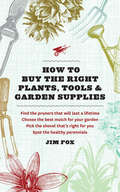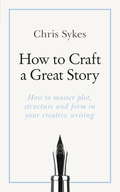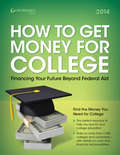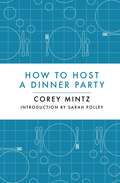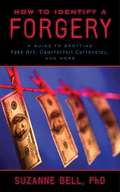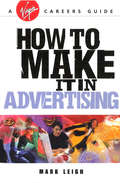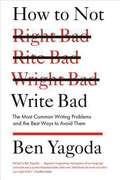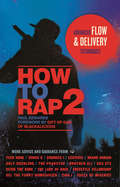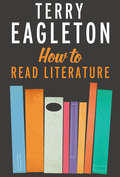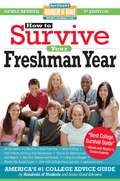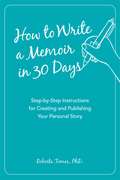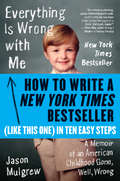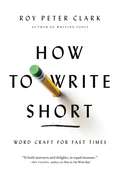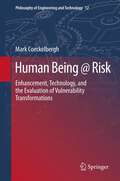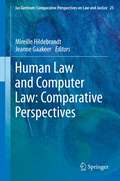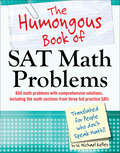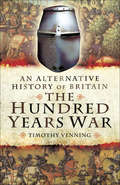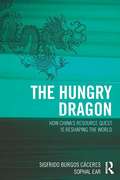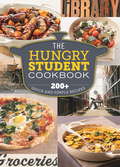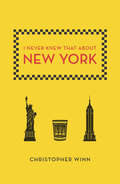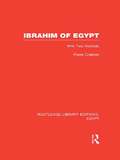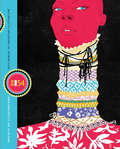- Table View
- List View
How to Buy the Right Plants, Tools, and Garden Supplies: Find The Pruners That Will Last A Lifetime Choose The Best Mulch For Your Garden Pick The Shovel That's Right For You Spot The Healthy Perennials
by Jim FoxAre you confused by all the choices when you visit a nursery? Do you get sticker shock when you see how much that nice little shade tree costs? Let Jim Fox, a nursery professional with over twenty years of experience, show you how to become a savvy garden consumer and get the most for your hard-earned landscaping dollars. <P><P>How to Buy the Right Plants, Tools, and Garden Supplies will arm you with a wealth of knowledge! You’ll learn how to determine if a plant is healthy, how to choose the right size, how to correctly read the plant tag, how to choose the best tools and supplies for your needs, and how to confidently recognize a well-made tool. <P><P> In addition to helping you navigate the nursery, it tells you what you need to know before you get there and offers helpful tips on how to successfully garden once you get home.With this essential guide in hand, you’ll never experience buyer’s remorse again!
How to Craft a Great Story: Teach Yourself Creating Perfect Plot and Structure
by Chris SykesLEARN HOW TO PLOT AND STRUCTURE YOUR CREATIVE WRITING.How to Craft a Great Story takes you step by step through the process of creating a compelling and coherent plot and structure. It covers such basics as the traditional story arcs, and such advanced information as finding balance and marrying structure and form. Each chapter contains a diagnostic test, case studies, practical exercises and Aide Memoire boxes. Each chapter concludes with a reminder of the key points of the chapter (Focus Points) and a round-up of what to expect in the next (Next Step) will whet your appetite for what's coming and how it relates to what you've just read. Covering some of the most commonly raised questions in creative writing courses, it is perfect for anyone who needs the next step on from the basic 'how to write a novel'.ABOUT THE SERIESThe Teach Yourself Creative Writing series helps aspiring authors tell their story. Covering a range of genres from science fiction and romantic novels, to illustrated children's books and comedy, this series is packed with advice, exercises and tips for unlocking creativity and improving your writing. And because we know how daunting the blank page can be, we set up the Just Write online community at tyjustwrite, for budding authors and successful writers to connect and share.
How to Get Money for College 2014: Financing Your Future Beyond Federal Aid
by Peterson'SHow to Get Money for College: Financing Your Future Beyond Federal Aid 2014 is a great resource for anyone looking to supplement his or her federal financial aid package with aid from colleges and universities. <P><P>This comprehensive directory points the reader to complete and accurate information on need-based and non-need gift aid, loans, work-study, athletic awards, and more. <P>This eBook offers profiles of more than 2,400 schools' financial aid awards, including types of aid, percentages of students applying for and receiving aid, and average aid packages; comprehensive overview of the financial aid process, common financial aid questions, samples of financial aid award letters, and how to file the FAFSA and CSS/Financial Aid PROFILE®.
How to Host a Dinner Party
by Corey MintzA fun, informative guide to hosting the perfect party every time. "Every dinner party experience I’ve had in the last ten years at Corey’s has been incredible. But practice really does make perfect and I can now honestly say there is nowhere I’d rather be in the world than at his table … I can’t begin to express the relief I felt in reading this book and realizing there was a method to his success."- Sarah Polley, from the introduction We’ve all been there: twenty minutes before guests arrive, and you’re unsure if you’ve got enough wine, or enough chairs, or whether your friend is a vegetarian or a vegan. Hosting a dinner party is hard, but Corey Mintz can help. For his popular Toronto Star column, "Fed," he has presided over 115 dinner parties, every week opening his home to strangers and friends alike in an effort to perfect the craft of hosting. And in How to Host a Dinner Party, he shares everything he’s learned in a hilarious handbook that will appeal to everyone — from those throwing their first dinner party to seasoned entertainers looking to enhance their skills. This book guides readers through everything they need to know about hosting, starting with the golden rule — that the goal of a dinner party is to have fun with our friends, not to show off our cooking skills. It will explain why we like to gather for dinner, when we should host, who we should invite, what we should cook, and how we should cook it. Featuring recipes, anecdotes, expert analysis, and an endless bounty of how-to tips, it is the essential guide to perfecting the art of welcoming people into your home.
How to Identify a Forgery: A Guide to Spotting Fake Art, Counterfeit Currencies, and More
by Suzanne BellFakes and counterfeits have existed since ancient times; and while the methods of forgery have surely advanced, so has the science necessary to identify them. Currency, art, and historical artifacts are only a few of the objects commonly forged; and scientists in forensic laboratories throughout the world work alongside artists, museums, linguists, and historians to authenticate these items. How to Identify a Forgery investigates how modern computers, printers, and scanners have presented new challenges for scientists and how objects suspected of being faked, forged, or fraudulent are examined forensically.How to Identify a Forgery contains information on: Counterfeiting currency Electronic and digital signatures Dating ink Dyes and pigments Forging art Handwriting analysis Scientific methodology Visual examination and microscopyHow to Identify a Forgery contains illustrations, a glossary, and a detailed list of print and web resources. Sidebars on notable cases and pressing forensics issues throughout reinforce the text. Essential for students, teachers, collectors, and investigators who require information on proper forensic science practices, Dr. Bell's book is as fascinating as it is useful.
How To Make It In Advertising
by Mark LeighAdvertising. Is it really 'the greatest art form of the twentieth century' (Marshall McLuhan)? Whatever your views, it is undeniably one of the most popular career choices going-and one of the most difficult to get into. If you want to be creative and make money, or simply fancy trying your handat a job in one of the most powerful industries around, then this indispensable guide is all you'll need to get a foot in the door and keep a step ahead of the competition. It's a careers guide with a difference, using the experience and wisdom of some of the industry's top people. You'll find essential advice on how to get started and how to get ahead, as well as the insider's view of the genuine pros and cons of each job, from copywriter to account handler. Your new career starts here.
How to Not Write Bad: The Most Common Writing Problems and the Best Ways to Avoid Them
by Ben YagodaBen Yagoda's How to Not Write Bad illustrates how we can all write better, more clearly, and for a wider readership. He offers advice on what he calls "not-writing-badly," which consists of the ability, first, to craft sentences that are correct in terms of spelling, diction (word choice), punctuation, and grammar, and that also display clarity, precision, and grace. Then he focuses on crafting whole paragraphs-with attention to cadence, consistency of tone, sentence transitions, and paragraph length. In a fun, comprehensive guide, Yagoda lays out the simple steps we can all take to make our writing more effective, more interesting-and just plain better. .
How to Rap 2: Advanced Flow and Delivery Techniques
by Paul Edwards Gift Of GabIn this sequel to How to Rap, techniques that have not previously been explained--such as triplets, flams, lazy tails, and breaking rhyme patterns--are thoroughly broken down and examined, arming readers with additional tools for their rapping repertoire. Filled with interviews from hip-hop's most innovative artists, including Tech N9ne, Crooked I, Pharcyde, Das EFX, Del the Funky Homosapien, and Big Daddy Kane, this book takes you through the intricacies of rhythm, rhyme, and vocal delivery, delving into the art form in unprecedented detail. This work is a must-read for MCs looking to take their craft to the next level, as well as anyone fascinated by rapping and its complexity.
How to Read Literature
by Terry EagletonWhat makes a work of literature good or bad? How freely can the reader interpret it? Could a nursery rhyme like Baa Baa Black Sheep be full of concealed loathing, resentment, and aggression? In this accessible, delightfully entertaining book, Terry Eagleton addresses these intriguing questions and a host of others. How to Read Literature is the book of choice for students new to the study of literature and for all other readers interested in deepening their understanding and enriching their reading experience.In a series of brilliant analyses, Eagleton shows how to read with due attention to tone, rhythm, texture, syntax, allusion, ambiguity, and other formal aspects of literary works. He also examines broader questions of character, plot, narrative, the creative imagination, the meaning of fictionality, and the tension between what works of literature say and what they show. Unfailingly authoritative and cheerfully opinionated, the author provides useful commentaries on classicism, Romanticism, modernism, and postmodernism along with spellbinding insights into a huge range of authors, from Shakespeare and J. K. Rowling to Jane Austen and Samuel Beckett.
How to Survive Your Freshman Year
by Frances Northcutt Yadin Kaufmann Ed.D. Scott Silverman Mark W. BernsteinHow to Survive Your Freshman Year offers incoming college freshmen the experience, advice, and wisdom of their peers: hundreds of other students who have survived their first year of college and have something interesting to say about it. Based on interviews with hundreds of college students at every type of higher-learning institution across the country, this book has insights on every aspect of college life, including, what to take to the dorm, living with roommates, Facebook and other social networks, extracurricular activities, choosing classes, studying, going abroad, finances, food, the social scene, doing laundry, staying in touch with friends and family, and much more. Highly readable, much of the book consists of short snippets with some interesting insight and advice from the college students interviewed. The book also includes expert input from college advisors and officers.
How to Write a Memoir in 30 Days
by Roberta TemesHow to Write Your Memoir in 30 Days provides the framework for writers enthusiastic about telling their story, but wondering how to begin. Step-by-step techniques, culled from writers' workshops taught by the author, are presented in a welcoming, non-intimidating style. The prospect of writing a book is not daunting when compartmentalized into thirty discrete assignments: Days 1 - 5 include exercises to identify major themes. Days 6 - 10 include exercises about plot. Days 11 - 15 include exercises about personalities. Days 16 - 20 include exercises about experiences. Days 21 - 25 include exercises that analyze responses to events. Days 26 - 30 include exercises that structure the story of the memoir. The book also includes information about publishers and literary agents, as well as information and resources about self-publishing. It also includes quick "clear communication" lessons about spelling and grammar. Perfect for today's society, where we are all accustomed to celebrating each of life's passages with a blog post and comfortable sharing our innermost feelings, How to Write a Memoir in 30 Days is a fun, easy guide to writing the next great memoir.
How to Write a New York Times Bestseller in Ten Easy Steps (eBook Original)
by Jason MulgrewDownload, for free!, a hilarious essay by New York Times bestselling author Jason Mulgrew, plus get a sneak peek from his new book, 236 Pounds of Class Vice President, available February 12, 2013. For a few "glorious" weeks, Jason Mulgrew's first book, Everything Is Wrong with Me, appeared on the New York Times bestseller list, before dropping off and returning to the deep obscurity to which it belongs. Jason Mulgrew has not been able to shut up about it since and now believes that he is qualified to write the following primer, "How to Write a New York Times Bestseller in Ten Easy Steps." Please accept our apologies in advance.
How to Write Short: Word Craft for Fast Times
by Roy Peter ClarkAmerica's most influential writing teacher offers an engaging and practical guide to effective short-form writing.In HOW TO WRITE SHORT, Roy Peter Clark turns his attention to the art of painting a thousand pictures with just a few words. Short forms of writing have always existed-from ship logs and telegrams to prayers and haikus. But in this ever-changing Internet age, short-form writing has become an essential skill. Clark covers how to write effective and powerful titles, headlines, essays, sales pitches, Tweets, letters, and even self-descriptions for online dating services. With examples from the long tradition of short-form writing in Western culture, HOW TO WRITE SHORT guides writers to crafting brilliant prose, even in 140 characters.
Human Being @ Risk: Enhancement, Technology, and the Evaluation of Vulnerability Transformations
by Mark CoeckelberghWhereas standard approaches to risk and vulnerability presuppose a strict separation between humans and their world, this book develops an existential-phenomenological approach according to which we are always already beings-at-risk. Moreover, it is argued that in our struggle against vulnerability, we create new vulnerabilities and thereby transform ourselves as much as we transform the world. Responding to the discussion about human enhancement and information technologies, the book then shows that this dynamic-relational approach has important implications for the evaluation of new technologies and their risks. It calls for a normative anthropology of vulnerability that does not ask which objective risks are acceptable, how we can become invulnerable, or which technologies threaten human nature, but which vulnerability transformations we want. To the extent that we can steer the growth of new technologies at all, this tragic and sometimes comic project should therefore be guided by what we want to become.
Human Evolution
by Graeme FinlayControversy over human evolution remains widespread. However, the human genome project and genetic sequencing of many other species have provided myriad precise and unambiguous genetic markers that establish our evolutionary relationships with other mammals. Human Evolution: Genes, Genealogies and Phylogenies identifies and explains these identifiable, rare and complex markers including endogenous retroviruses, genome-modifying transposable elements, gene-disabling mutations, segmental duplications and gene-enabling mutations. The new genetic tools also provide fascinating insights into when and how many features of human biology arose: from aspects of placental structure, vitamin C dependence and trichromatic vision, to tendencies to gout, cardiovascular disease and cancer. Bringing together a decade's worth of research and tying it together to provide an overwhelming argument for the mammalian ancestry of the human species, the book will be of interest to professional scientists and students in both the biological and biomedical sciences.
Human Law and Computer Law: Comparative Perspectives
by Jeanne Gaakeer Mireille HildebrandtThe focus of this book is on the epistemological and hermeneutic implications of data science and artificial intelligence for democracy and the Rule of Law. How do the normative effects of automated decision systems or the interventions of robotic fellow 'beings' compare to the legal effect of written and unwritten law? To investigate these questions the book brings together two disciplinary perspectives rarely combined within the framework of one volume. One starts from the perspective of 'code and law' and the other develops from the domain of 'law and literature'. Integrating original analyses of relevant novels or films, the authors discuss how computational technologies challenge traditional forms of legal thought and affect the regulation of human behavior. Thus, pertinent questions are raised about the theoretical assumptions underlying both scientific and legal practice.
The Humongous Book of SAT Math Problems: 750 Math Problems with Comprehensive Solutions for the Math Portion of the SAT (Humongous Books)
by W. Michael KelleyTranslating math for people who don't speak math! The Humongous Book of SAT Math Problems takes a typical SAT study guide of solved math problems and provides easy-to-follow margin notes that add missing steps and simplify the solutions, thereby better preparing students to solve all types of problems that appear in both levels of the SAT math exam. Award-winning teacher W. Michael Kelley offers 750 problems with step-by-step notes and comprehensive solutions. The Humongous Books are like no other math guide series!
The Hundred Years War: The Hundred Years War
by Timothy VenningContinuing his exploration of the alternative paths that British history might so easily have taken, Timothy Venning turns his attention to the Hundred Years War between England and France. Could the English have won in the long term, or, conversely, have been decisively defeated sooner? Among the many scenarios discussed are what would have happened if the Black Prince had not died prematurely of the Black Death, leaving the 10-year-old Richard to inherit Edward IIIs crown. What would have been the consequences if France's Scottish allies had been victorious at Neville's Cross in 1346, while most English forces were occupied in France? What if Henry V had recovered from the dysentery that killed him at 35, giving time for his son Henry VI to inherit the combined crowns of France and England as a mature (and half-French) man rather than an infant controlled by others? And what if Joan of Arc had not emerged to galvanize French resistance at Orleans? While necessarily speculative, all the scenarios are discussed within the framework of a deep understanding of the major driving forces, tensions and trends that shaped British history and help to shed light upon them. In so doing they help the reader to understand why things panned out as they did, as well as what might have been in this fascinating period that still arouses such strong passions on both sides of the Channel.
The Hungry Dragon: How China's Quest for Resources is Reshaping the World
by Sigfrido Burgos Cáceres Sophal EarThis volume provides an up to date and accessible examination of China's global search for resources, focusing primarily on oil. This focus provides a powerful rationale to explain China's actions overseas, as it impacts on economic, energy and foreign policies. A strong feature of the book is a comprehensive examination of geopolitical issues. Three country case studies (Angola, Brazil and Cambodia) are complemented by two chapters on opportunities and risks to China, and an examination as to how strategies are developed into tangible actions. This book also examines a number of overlapping debates regarding the varieties of capitalisms (autocratic vs. democratic), the urgent need for rebalancing as the world undergoes global crises, and the issues surrounding natural resources in the context of governance, liberal-oriented notions and poverty traps. The book is aimed at general as well as specialized readers and examines the subject in relation to international affairs, especially how the geopolitics of scarcity is driving states to be tenser, more observant of each other, and more acute to foreign initiatives.
The Hungry Student Cookbook: 200+ Quick and Simple Recipes (The Hungry Cookbooks)
by Pauline BacheA student cookbook with a difference, The Hungry Student not only gives more than 200 quick, cheap and tasty recipes that will impress all your mates, but there are also indispensable tips on everything the new student needs to know, from barbecuing tips and drinking games, to how to tackle those tricky household chores. With chapters dedicated to PhD in One Pot, Outdoor Grub, Mates for Tea, Strapped for Cash, Eat Healthy, Bachelor of Budget Bakes & Puds, Back to Basics and The Bar, there are opportunities for impromptu parties, end of the month budget creations and comfort foods for one.Each recipe has a cost breakdown to help with budgeting and detailed instructions to make them accessible to even the most novice cook. While Eat Healthy contains full nutritional information to prep your body and brain for intensive studying (and partying!)Forget the textbooks, this is the only book you'll ever need to get through your first year!
I Never Knew That About New York
by Christopher WinnA treasure trove of fascinating trivia about the city that never sleeps Did you know: Grand Central Terminal is the largest railway station in the world. Columbus Circle is the point from which all official distances to and from New York are measured When Queen Elizabeth II visited Trinity Church in 1976, she was presented with 279 peppercorns in back rent Macy’s owns almost a full city block...but not the real estate its famous sign featuring its signature red bag is on. Take a delightful journey from the bottom of the island of Manhattan to the top and discover extraordinary facts about New York along the way. You’ll find yourself saying, "I never knew that about New York!” .
IB Prepared: Environmental Systems and Societies SL
by Andrew Davis Garrett NagleThis book is one of the many resources required for preparation of final Environmental System and Societies ( ESS ) Standard Level (SL) exams.
Ibrahim of Egypt (Routledge Library Editions: Egypt)
by Pierre CrabitèsThe name and fame of Muhammad Ali, the Founder of Modern Egypt, are well known. His vivid personality has appealed to many writers, who have concentrated the limelight on him. Some of them have allowed Muhammad Ali’s son, Ibrahim, to appear on the stage, but they have assigned him a more or less obscure role. They refer to him as the sword wielded by his astute father, and have usually treated him as if he knew nothing of statesmanship, and were merely a bluff soldier whose military talents happened to be superior to those of the generals opposed to him. This book seeks to redress this error and bring the truth into its proper perspective. It does not belittle the glory of Muhammad Ali, but it stresses the part played by Ibrahim in the affairs of Egypt. First published 1935.
Identification Of Children With Visual Impairment And Assessment Of Needs - NSOU (SEVI - 31)
by Netaji Subhas Open UniversityPublished by Netaji Subhas Open University, The Bachelor of Education Programme through Open and Distance Learning Mode contains the compulsory course with 5 units in it.
Illustrators 54
by The Society of IllustratorsThis 54th edition of the Society of Illustrators Annual represents the very best work created throughout the year. These volumes have been collected and treasured for decades by those interested in the art of illustration, and are not only an invaluable source for art buyers, but also keep professional artists abreast of current trends and serve as inspirational teaching tools for art students and those entering the field. Highlights include: Revealing commentary by individual artists describing the creative process behind their works. Gold and Silver Medal winners in seven categories. Biographies of the artists elected to the prestigious Illustrators Hall of Fame, along with examples of their work. Profiles of the Hamilton King Award and the Richard Gangel Art Director Award winners.
